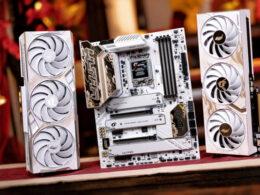Innovative Graphics Processing Redefined
Pongsagon Vichit, an aficionado of FPGA and retro computing, has unveiled the TinyGPU v2.0, an autonomous graphics processor adept at executing the full cycle of basic 3D rendering. From transformations and lighting to rasterization, this innovation is paving the way for compact, budget-friendly graphics solutions. Developed through the Tiny Tapeout initiative, the TinyGPU aims to realize a chip within a constraints of only 200,000 transistors at its maximum 4×4 tile configuration. In stark contrast, the flagship Nvidia GeForce RTX 5090 boasts 92.2 billion transistors, highlighting TinyGPU’s minimalist yet purposeful design.
FPGA-Powered Real-Time Graphics
Vichit, also known as @MattDIYgraphics, showcased TinyGPU v2.0 on a Basys3 FPGA board. The design, embedded into the chip, uploads 3D models from its internal memory, capable of real-time rotation with the aid of a Super Nintendo gamepad. Users can further manipulate light sources with the same controller, underlining the project’s core concept – implementing a “real” 3D pipeline within a strict transistor budget.
Technical Specifications and Market Comparison
Technically, the TinyGPU v2.0 operates at a frequency of 25 MHz, outputting a frame rate of approximately 7.5–15 fps. The rendering resolution caps at 320×240 pixels with 4-bit color, translating to 16 simultaneous shades on the screen. Vichit notes that the silicon version based on Tiny Tapeout will not exceed the performance demonstrated on the Basys3 platform, and thus should not be expected to deliver “game-level” performance.

Reviving the Retro with Modern Techniques
Though reminiscent of early 1980s home computers, the TinyGPU v2.0 includes functions typical of later graphics generations. It performs interactive transformations of 3D vectors into raster images and uses hardware transformation and lighting blocks – a methodology popularized with Nvidia’s GeForce 256 in October 1999. Here, transformation entails mathematical operations like rotation, scaling, and projecting a 3D model onto a screen. Meanwhile, lighting involves calculating surface brightness based on the light source.
Capabilities and Community Engagement
Among the TinyGPU v2.0’s capabilities are a 4-bit dual frame buffer for smoother output, an 8-bit depth buffer in QSPI RAM for storing pixel distance information, support for up to 1,000 triangles per scene, backface culling, one dynamic directional light source, and flat shading. The project is poised for the next Tiny Tapeout launch, with the maximum 16-tile configuration costing approximately $1,500. The Verilog source code and documentation are available on GitHub, positioning the TinyGPU v2.0 as a fully open platform for learning and modification.
A Platform for Learning and Experimentation
Vichit’s prior involvement in Tiny Tapeout 7 with the Tiniest GPU project laid the groundwork for his current endeavor. The previous project supported only two polygons but operated at 50 MHz with outputs of 640×480 pixels, 6-bit color, and up to 60 fps. The true value of TinyGPU v2.0 lies not in competing with commercial GPUs, but in demonstrating how a complete hardware 3D pipeline can be realized within a stringent transistor budget, inviting in-depth exploration.





